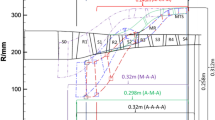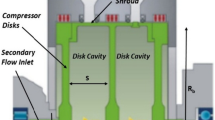Abstract
Predicting the exact performance of multi-stage compressors for an aircraft gas turbine is important in the design process and calculation of off-design characteristics. This study explores the quantitative effects of cold-to-hot deformation on the aerodynamic performance of a three-stage axial compressor in terms of power consumption and efficiency. The reason of difference between numerical result and performance test data is investigated. Three-dimensional computational fluid dynamics (3D CFD) was used to predict the flow characteristics. A finite-element (FE) analysis was conducted to calculate the displacement caused by rotation, thermal expansion, and pressure force. First, the fluid domain of the compressor with cold geometry was analyzed via a 3D CFD analysis, and the displacement for all coordinates was then obtained from the FE analysis. The hot geometry and mesh for the fluid domain were generated based on the cold geometry and calculated displacement. Finally, the aerodynamic performance of the compressor with hot geometry was evaluated via a 3D CFD analysis. The results for the hot geometry compressor were more consistent with the performance test data than those for the cold geometry compressor in terms of the pressure ratio and efficiency based on the mass flow rate. Moreover, the average rotor tip clearance decreased by approximately 0.5% with respect to the span height by the cold-to-hot deformation. The total pressure loss at the rotor tip region was lower for the hot geometry compressor than the cold geometry compressor because of the reduced entropy of the high vortex loss core around the rotor tips. The results showed that the power consumption was 1.16% higher for the hot geometry compressor than the cold geometry compressor at the designed pressure ratio, which was primarily caused by an increase in the mass flow rate due to the wider throat area after the cold-to-hot deformation.




















Similar content being viewed by others
References
UNFCCC (2015) Adoption of the Paris agreement (1/CP.21). United Nations Framework Convention on Climate Change, Bonn
Pan X, den Elzen M, Höhne N, Teng F, Wang L (2017) Exploring fair and ambitious mitigation contributions under the Paris agreement goals. Environ Sci Policy 74:49–56
Graham WR, Hall CA, Morales MV (2014) The potential of future aircraft technology for noise and pollutant emissions reduction. Transp Policy 34:36–51
Gallar L, Arias M, Pachidis V, Singh R (2011) Stochastic axial compressor variable geometry schedule optimization. Aerosp Sci Technol 15(5):366–374
Kim S, Kim D, Son C, Kim K, Kim M, Min S (2015) A full engine cycle analysis of a turbofan engine for optimum scheduling of variable guide vanes. Aerosp Sci Technol 47:21–30
Li B, Gu CW, Li XT, Liu TQ (2016) Numerical optimization for stator vane settings of multi-stage compressors based on neural networks and genetic algorithms. Aerosp Sci Technol 52:81–94
Puente R, Corral R, Parra J (2018) Comparison between aerodynamic designs obtained by human driven and automatic procedures. Aerosp Sci Technol 72:443–454
Zhang C, Hu J, Li J, Wang Z (2017) Three-dimensional compressor blading design improvements in low-speed model testing. Aerosp Sci Technol 63:179–190
Zhang H, Chen S, Meng Q, Wang S (2018) Flow separation control using unsteady pulsed suction through endwall bleeding holes in a highly loaded compressor cascade. Aerosp Sci Technol 72:455–464
Chu W, Li X, Wu Y, Zhang H (2016) Reduction of end wall loss in axial compressor by using non-axisymmetric profiled end wall: a new design approach based on end wall velocity modification. Aerosp Sci Technol 55:76–91
Schulz HD, Gallus HE, Lakshminarayana B (1990) Three-dimensional separated flow field in the endwall region of an annular compressor cascade in the presence of rotor–stator interaction: Part 1—Quasi-steady flow field and comparison with steady-state data. J Turbomach 112:669–690
Lu H, Li Q, Pan T (2016) Optimization of cantilevered stators in an industrial multistage compressor to improve efficiency. Energy 106:590–601
Wiedermann A, Frank D, Orth U, Beukenberg M (2011) Computational and experimental analysis of an industrial gas turbine compressor. ASME Turbo Expo, Vancouver
Taghavi-Zenouz R, Behbahani MHA (2018) Improvement of aerodynamic performance of a low speed axial compressor rotor blade row through air injection. Aerosp Sci Technol 72:409–417
Kim J, Jung YJ, Shin Y, Choi M (2015) Effects of real geometry on the performance in a centrifugal compressor. In: The 13th Asian international conference on fluid machinery, Tokyo
Liu Y, Yan H, Lu L (2015) Investigation of corner separation in a linear compressor cascade using DDES. ASME Turbo Expo, Montréal
Du J, Lin F, Chen J, Nie C, Biela C (2013) Flow structures in the tip region for a transonic compressor rotor. J Turbomach 135(3):031012
Cornelius C, Biesinger T, Galpin P, Braune A (2014) Experimental and computational analysis of a multistage axial compressor including stall prediction by steady and transient CFD methods. J Turbomach 136(6):061013
Kim C, Lee H, Yang J, Son C, Hwang Y (2016) Study on the performance of a centrifugal compressor considering running tip clearance. Int J Refrig 65:92–102
Persson A, Runsten J (2011) CFD investigation of a 3.5 stage transonic axial compressor including real geometry effects. Chalmers University of Technology, Sweden
Janke C, Karger K, Gaun L, Bestle D, Huppertz A (2014) 3D CFD compressor map computation process accounting for geometry changes due to off-design operation loads. ASME Turbo Expo, Düsseldorf
Wang L, Quant R, Kolios A (2016) Fluid structure interaction modelling of horizontal-axis wind turbine blades based on CFD and FEA. J Wind Eng Ind Aerodyn 158:11–25
Lee K, Huque Z, Kommalapati R, Han SE (2017) Fluid–structure interaction analysis of NREL phase VI wind turbine: aerodynamic force evaluation and structural analysis using FSI analysis. Renew Energy 113:512–531
Kang YS, Park TC, Hwang OS, Yang SS (2011) Experimental research on multi stage transonic axial compressor performance evaluation. KSFM J Fluid Mach 14(6):96–101
Spalart PR, Allmaras SR (1994) A one equation turbulence model for aerodynamic flows. 30th aerospace sciences meeting and exhibit, Reno
Kim S, Kim D, Kim K, Son C, Kim M, Min S (2015) New profile loss model for improved prediction of transonic axial flow compressor performance in choking region. ASME Turbo Expo, Montréal
Hourmouziadis J (1989) Blading design for axial turbomachines. In: Propulsion and energetics panel of AGARD and the consultant and exchange programme of AGARD, Toronto
Acknowledgements
This work was supported by the Human Resources Development program (No. 20184030202060) of the Korea Institute of Energy Technology Evaluation and Planning (KETEP) grant funded by the Korea government Ministry of Trade, Industry and Energy. And this work was supported by the Korea Institute of Energy Technology Evaluation and Planning (KETEP) and the Ministry of Trade, Industry & Energy (MOTIE) of the Republic of Korea (No. 20181110100400).
Author information
Authors and Affiliations
Corresponding author
Rights and permissions
About this article
Cite this article
Kim, S., Kim, K. & Son, C. Aerodynamic Performance of Multi-stage Axial Compressor Considering Cold-to-Hot Deformation Effect. Int. J. Aeronaut. Space Sci. 19, 651–660 (2018). https://doi.org/10.1007/s42405-018-0051-1
Received:
Revised:
Accepted:
Published:
Issue Date:
DOI: https://doi.org/10.1007/s42405-018-0051-1




